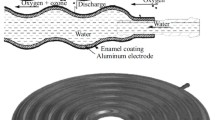Abstract
Technological conditions for obtaining titanium-borosilicate glasses and properties of enamel coating, spreadability of enamels, and luster of coatings are investigated. The effect of boron and alkali metal oxide on the physicochemical properties of titanium-borosilicate enamels is studied. A chemically resistant enamel for steel kitchenware is developed, with improved properties compared to currently used industrial enamels.
Similar content being viewed by others
REFERENCES
A. Petzold and G. Peschmann, Enamel and Enameling [Russian translation], Metallurgiya, Moscow (1990).
Enameling of Metallic Articles [in Russian], Mashinostroenie, Leningrad (1972).
N. M. Pavlushkin, G. G. Sentyurin, and R. Ya. Khodakovskaya, A Practical Course in Technology of Glass And Glass Ceramics [in Russian], Stroiizdat, Moscow (1970).
S. P. Zhdanov, “Possibility of the calculation of a content of tetrahedral boron in sodium-borosilicate glasses based on the glass composition,” Dokl. Akad. Nauk SSSR, 217(3), 581–584 (1974).
Author information
Authors and Affiliations
Rights and permissions
About this article
Cite this article
Rodtsevich, S.P., Eliseev, S.Y. & Tavgen', V.V. Low-Melting Chemically Resistant Enamel for Steel Kitchenware. Glass and Ceramics 60, 23–25 (2003). https://doi.org/10.1023/A:1023886032228
Issue Date:
DOI: https://doi.org/10.1023/A:1023886032228




